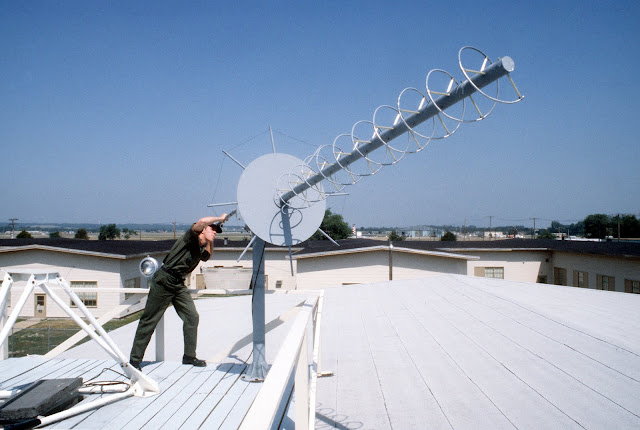U Slot Patch Antenna Design
Posted By admin On 14/04/22- Slot Antenna Design Formulas
- Design Of Triple Layer Double U-slot Patch Antenna For Wireless Applications
- Slot Antenna For Hf
The standard rectangular microstrip patch is a narrowband antenna and provides 6-8 dBi Gain with linear polarization. This example based on the work done in [1],[2], models a broadband patch antenna using a slot in the radiator and develops a dual-band and a tri-band variation from it. In the process, the single wide response has been split into multiple narrow band regions catering to specific bands in the WiMAX standard. These patch antennas have been probe-fed.
- Radiating patch is a very effective method for achieving a wide bandwidth. Several U-slot patch antennas has been reported recently to improve bandwidth8-10. To enhance the bandwidth we can increase the substrate thickness. However the size of an antenna is an important consideration in the design of patch antenna. The design of circular.
- Most of the reported work, an in-depth explanation about the mode introduced by U-slot and procedure to design U-slot cut antennas at any given frequency is not explained. In this paper, first an extensive analysis to study the broadband response in symmetrical and a new configuration of asymmetrical U-slot cut rectangular microstrip.
- The U-shaped patch antenna's radiation pattern is shown in Fig. 6, with the directional pattern typical of patch designs. Simulated maximum antenna gain is close to 9.5 dBi. Because of its compact size, generous bandwidth, and high gain, the U-shaped patch antenna is well suited for point-to-point applications in 5-GHz WLAN systems.
To validate the design technique antenna is fabricated and measured results are compared with the simulated to assess the performance. In this dissertation, effect of reactive loading on probe fed, single layer, U-Slot loaded microstrip antenna is investigated using Theory of Characteristic Modes (TCM). An analysis of broadband truncated corner rectangular microstrip patch antenna loaded with U-slot is presented using equivalent circuit approach based on cavity model. The U-slot and a pair of truncated corner are employed in a rectangular patch to achieve about 80.41% measured impedance bandwidth covering frequency range 2.58–6.05 GHz.
Building the Single U-Slot Patch
Define Parameters The basic U-slot patch antenna consists of a rectangular patch radiator within which a U-shaped slot has been cut out. As discussed in [1], the patch itself is on an air substrate and thick so as to enable higher bandwidths to be achieved. The presence of the slot structure achieves additional capacitance within the structure which combines with the inductance of the long probe feed to create a double resonance within the band. The geometry parameters based on [2] are defined and shown in a drawing below.
Define radiator shape - Single U-slot
Use the rectangle shape primitives in Antenna Toolbox™ to create the U-slot patch radiator shape. Boolean subtraction operation is used among the shape primitives for this purpose.
Define ground shape
Slot Antenna Design Formulas
Create the ground plane shape for the antenna. The groundplane in this case is rectangular and 71 mm x 52 mm in size.
Define stack
Use the pcbStack to define the metal and dielectric layers and the feed for the single U-slot patch antenna. The layers are defined top-down. In this case, the top-most layer is a metal layer defined by the U-slot patch shape. The second layer is a dielectric material, air in this case, and the third layer is the metal ground plane.
Calculate and Plot Reflection Coefficient
Mesh the structure by using a maximum edge length which is one-tenth the wavelength at the highest frequency of operation which is 6 GHz for this example. Compute and plot the reflection coefficient for this antenna over the band. The reflection coefficient is plotted with a reference impedance of 50 ohms.
Calculate and plot pattern
Plot the radiation pattern for this antenna at the frequencies of best match in the band.
Dual-band U-Slot Patch Antenna
Define Parameters
To achieve dual-band behavior as shown in [1], [2], the double resonance is modified such that the two contributing resonances, i.e. from the patch and from the slot do not merge. To do so the existing slot parameters are adjusted and a second slot is introduced into the structure. The parameters for the double U-slot are listed below as per [2] and a figure annotated with the variables used is shown.
Create Double U-slot radiator
Design Of Triple Layer Double U-slot Patch Antenna For Wireless Applications
As before use the shape primitives, to create the geometry by using Boolean operations.
Modify Layers in Stack
Modify the existing stack by introducing the new radiator in the Layers property.
Mesh and Plot Reflection Coefficient

Mesh the structure at the highest frequency of operation and calculate the reflection coefficient.
Triple-Band U-slot Patch Antenna Parameters
For triple-band operation a third U-slot is introduced and the existing slot parameters are adjusted. The parameters are shown below based on [2].
Create Triple U-slot radiator

Modify Layers in Stack
Mesh and Plot Reflection Coefficient
Conclusion
The models of the multi-band single layer U-slot patch antenna as discussed in [1], and [2] have been built and analyzed and agree well with results reported.
Reference
[1] K. F. Lee, S. L. S. Yang and A. Kishk, 'The versatile U-slot patch antenna,' 2009 3rd European Conference on Antennas and Propagation, Berlin, 2009, pp. 3312-3314.


Slot Antenna For Hf
[2] W. C. Mok, S. H. Wong, K. M. Luk and K. F. Lee, 'Single-Layer Single-Patch Dual-Band and Triple-Band Patch Antennas,' in IEEE Transactions on Antennas and Propagation, vol. 61, no. 8, pp. 4341-4344, Aug. 2013.